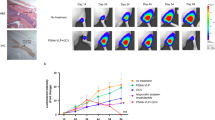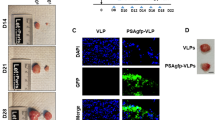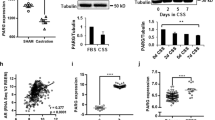Abstract
The Escherichia coli enzyme (purine nucleoside phosphorylase, PNP) gene is delivered directly into PC3 tumors by one injection of replication-deficient human type-5 adenovirus (Ad5). Expressed PNP converts the systemically administered prodrug, 6MPDR, to a toxic purine, 6MP, causing cell death. We sought to increase the specificity of recombinant Ad vectors by controlling PNP expression with the promoter region from the androgen-dependent, prostate-specific rat probasin (Pb) gene. To increase its activity, the promoter was combined with the SV40 enhancer (SVPb). Cell lines were transfected with plasmids containing both a reporter gene, under SVPb control, and a reference gene cassette to allow normalization of expression levels. Plasmids expressed ∼20-fold more reporter in prostate cancer than in other cells, but surprisingly, the SVPb element was both androgen-independent and retained substantial prostate specificity. Killing by Ad5-SVPb-PNP vector of cell lines cultured with 6MPDR for 6 days was 5- to 10-fold greater in prostate cancer than in liver or lung cells. In vivo, a single intratumoral injection of Ad5-SVPb-PNP (4×108 pfu), followed by 6MPDR administration twice daily for 6 days, significantly suppressed the growth of human prostate tumors in nude mice and increased their survival compared to control animals. Thus, the androgen-independent, prostate-targeting Ad5 vector reduces human prostate cancer growth significantly in vitro and in vivo. This first example of an androgen-independent vector points the way toward treatment of emerging androgen-independent prostate cancer in conjunction with hormone ablation therapy at a time when the tumor burden is low.
This is a preview of subscription content, access via your institution
Access options
Subscribe to this journal
Receive 12 print issues and online access
$259.00 per year
only $21.58 per issue
Buy this article
- Purchase on Springer Link
- Instant access to full article PDF
Prices may be subject to local taxes which are calculated during checkout





Similar content being viewed by others
References
Landis SH, Murray T, Bolden S, Wingo PA . Cancer statistics, 1998 Ca—Cancer J Clin 1998 48: 6–29
Malkowicz SB, Johnson JO . Gene therapy for prostate cancer [review] Haematol-Oncol Clin North Am 1998 12: 649–664
Palapattu GS, Naitoh J, Belldegurn AS . Gene therapy for prostate cancer. New perspectives on an old problem Urol Clin North Am 1999 26: 353–363
Aghi M, Hochberg F, Breakefield XO . Prodrug activation enzymes in cancer gene therapy J Gene Med 2000 2: 148–164
Culver KW, Ram Z, Wallbridge S, Ishii H, Oldfield EH, Blaese RM . In vivo gene transfer with retroviral vector–producer cells for treatment of experimental brain tumors Science 1992 256: 1550–1552
Freeman SM, Abboud CN, Wartenby KA et al. The “bystander effect”: tumor regression when a fraction of the tumor mass is genetically modified Cancer Res 1993 53: 5274–5283
Ram Z, Culver KW, Walbridge S, Blaese RM, Oldfield EH . In situ retroviral-mediated gene transfer for the treatment of brain tumors in rats Cancer Res 1993 53: 83–88
Oldfield EH, Ram Z, Culver KW, Blaese RM, De Vroom HL, Anderson WF . Gene therapy for the treatment of brain tumors using intra-tumoral transduction with the thymidine kinase gene and intravenous ganciclovir Hum Gene Ther 1993 4: 39–69
Moolten FL . Tumor chemosensitivity conferred by inserted herpes thymidine kinase genes; paradigm for a prospective cancer control strategy Cancer Res 1986 46: 5267–5281
Eastham J, Chen S-H, Sehgal I et al. Prostate cancer gene therapy: herpes simplex virus thymidine kinase gene transduction followed by ganciclovir in mouse and human prostate cancer models Hum Gene Ther 1996 7: 515–523
Hall SJ, Mutchnik SE, Chen S-H, Woo SLC, Thompson TC . Adenovirus-mediated herpes simplex virus thymidine kinase gene and ganciclovir therapy leads to systemic activity against spontaneous and induced metastasis in an orthotopic mouse model of prostate cancer Int J Cancer 1997 70: 183–187
Hall SJ, Sanford MA, Atkinson G, Chen SH . Induction of potent antitumor natural killer cell activity by herpes simplex virus thymidine kinase and ganciclovir therapy in an orthotopic mouse model of prostate cancer Cancer Res 1998 58: 3221–3225
Hermann JR, Adler HL, Aguilar-Cordova EA et al. In situ gene therapy for adenocarcinoma of the prostate: a phase I clinical trial Hum Gene Ther 1999 10: 1239–1249
Trinh T, Austin EA, Murray DM, Knick VC, Huber BE . Enzyme/prodrug gene therapy: comparison of cytosine deaminase/5-fluorocytosine versus thymidine kinase/ganciclovir enzyme/prodrug systems in a human colorectal carcinoma cell line Cancer Res 1995 55: 4808–4812
Hirschowitz EA, Ohwada A, Pascal WR, Russi TJ, Crystal RG . In vivo adenovirus mediated gene transfer of E. coli cytosine deaminase gene to human colon carcinoma derived tumors induces chemosensitization to 5-flurocytosine Hum Gene Ther 1995 6: 1055–1063
Blackburn RV, Galoforo SS, Corry PM, Lee YJ . Adenoviral transduction of a cytosine deaminase/thymidine kinase fusion gene into prostate carcinoma cells enhances prodrug and radiation sensitivity Int J Cancer 1999 82: 293–297
Sorscher EJ, Peng S, Bebok Z, Allan PW, Bennett LL Jr, Parker WB . Tumor cell bystander killing in colonic carcinoma utilizing the Escherichia coli DeoD gene to generate toxic purines Gene Ther 1994 1: 233–238
Lockett LJ, Molloy PL, Russell PJ, Both GW . Relative efficiency of tumor cell killing in vitro by two enzyme–prodrug systems delivered by identical adenovirus vectors Clin Cancer Res 1997 3: 2075–2080
Hughes BW, Wells AH, Bebok Z et al. Bystander killing of melanoma cells using the human tyrosinase promoter to express the Escherichia coli purine nucleoside phosphorylase gene Cancer Res 1995 55: 3339–3345
Parker WB, Allan PW, Shaddix SC et al. Metabolism and metabolic actions of 6-methylpurine and 2-fluoroadenine in human cells Biochem Pharmacol 1998 55: 1673–1681
Secrist JA III, Parker WB, Allan PW et al. Gene therapy of cancer: activation of nucleoside prodrugs with E. coli purine nucleoside phosphorylase Nucleosides Nucleotides 1999 18: 745–757
Berges RR, Vukanovic J, Epstein JI et al. Implication of cell kinetic changes during progression of human prostatic cancer Clin Cancer Res 1995 1: 473–480
Martiniello-Wilks R, Garcia-Aragon J, Daja M et al. In vivo gene therapy for prostate cancer: preclinical evaluation of two different enzyme–prodrug systems delivered by identical adenovirus vectors Hum Gene Ther 1998 9: 1617–1626
Brookes DE, Campbell-Zandvleit D, Watt F, Russell PJ, Molloy PL . Relative activity and specificity of promoters from prostate-expressed genes Prostate 1998 35: 18–26
Pang S, Dannull J, Kaboo R et al. Identification of a positive regulatory element responsible for tissue-specific expression of prostate-specific antigen Cancer Res 1997 57: 495–499.27
Russell PJ, Martiniello-Wilks R, Lockett LJ et al. Prostate cancer gene therapy Australas Biotechnol 1998 8: 99–106
Greenberg NM, deMayo FJ, Sheppard PC et al. The rat probasin gene promoter directs hormonally and developmentally regulated expression of a heterologous gene specifically to the prostate in transgenic mice Mol Endocrinol 1994 8: 230–239
Raghow S, Kuliyev E, Steakley M, Greenberg N, Steiner MS . Efficacious chemoprevention of primary prostate cancer by flutamide in an autochthonous transgenic model Cancer Res 2000 60: 4093–4097
Kasper S, Sheppard PC, Yan Y et al. Development, progression, and androgen-dependence of prostate tumors in probasin-large T antigen transgenic mice: a model for prostate cancer Lab Invest 1998 78: i–xv
Douglas JT, Rogers BE, Rosenfeld ME, Michael SI, Feng MZ, Curiel DT . Targeted gene delivery by tropism-modified adenoviral vectors Nat Biotechnol 1996 14: 1574–1578
Romanczuk H, Galer CE, Zabner J, Barsomian G, Wadsworth SC, O'Riordan CR . Modification of an adenoviral vector with biologically selected peptides: a novel strategy for gene delivery to cells of choice Hum Gene Ther 1999 10: 2615–2626
Schuur ER, Henderson GA, Kmetec LA, Miller JD, Lamparski HG, Henderson DR . Prostate-specific antigen expression is regulated by an upstream enhancer J Biol Chem 1996 271: 7043–7051
Zhang SB, Murtha PE, Young CYF . Defining a function androgen responsive element in the 5′ far upstream flanking region of the prostate specific-antigen gene Biochem Biophys Res Commun 1997 231: 784–788
Cleutjens KB, van der Korput HA, Ehren-van Eekelen CC et al. A 6-kb promoter fragment mimics in transgenic mice the prostate-specific and androgen-regulated expression of the endogenous prostate-specific antigen gene in humans Mol Endocrinol 1997 11: 1256–1265
Kasper A, Rennie PS, Bruchovsky N et al. Cooperative binding of androgen receptors to two DNA sequences is required for androgen induction of the probasin gene J Biol Chem 1994 269: 3173–3179
Yan Y, Sheppard PC, Kasper S et al. Large fragment of the probasin promoter targets high levels of transgene expression to the prostate of transgenic mice Prostate 1997 32: 129–139
Smiley WR, Laubert B, Howard BD et al. Establishment of parameters for optimal transduction efficiency and anti-tumor effects with purified high-titer HSV-TK retroviral vector in established solid tumors Hum Gene Ther 1997 8: 965–977
Smythe WR, Hwang HC, Elshami AA et al. Treatment of experimental mesothelioma using adenovirus transfer of the herpes simplex thymidine kinase gene Ann Surg 1995 222: 78–86
Tong X-W, Agoulnik I, Blankenburg K et al. Human epithelial ovarian cancer xenografts into nude mice can be cured by adenovirus-mediated thymidine kinase gene therapy Anticancer Res 1997 17: 811–814
Hayashi S, Emi N, Yokoyama I, Namii Y, Uchida K, Takagi H . Inhibition of establishment of hepatic metastasis in mice by combination gene therapy using both herpes simplex virus–thymidine kinase and granulocyte–macrophage colony stimulating factor genes in murine colon cancer Cancer Gene Ther 1997 4: 339–344
Parker WB, King SA, Allan PW et al. In vivo gene therapy of cancer with E. coli purine nucleoside phosphorylase Hum Gene Ther 1997 8: 1637–1644
Chen SH, Kosai K, Xu B et al. Combination suicide and cytokine gene therapy for hepatic metastases of colon carcinoma: sustained antitumor immunity prolongs animal survival Cancer Res 1996 56: 3758–3762
O'Malley BW Jr, Cope KA, Chen SH, Li DQ, Schwartz MR, Woo SLC . Combination gene therapy for oral cancer in a murine model Cancer Res 1996 56: 1737–1741
Russell PJ, Wass J, Lukeis R et al. Characterization of cell lines derived from a multiply aneuploid human bladder transitional-cell carcinoma, UCRU-BL-13 Int J Cancer 1989 44: 276–85
Thalmann GN, Sikes RA, Chang S-M, Johnston DA, von Eschenbach AC, Chung LWK . Suramin-induced decrease in prostate-specific antigen expression with no effect on tumor growth in the LNCaP model of human prostate cancer J Natl Cancer Inst 1996 88: 794–801
Spessot R, Inchley K, Hupel TM, Bacchetti S . Cloning of the herpes simplex virus ICP4 gene in an adenovirus vector: effects on adneovirus gene expression and replication Virology 1989 168: 378–387
Graham FL, Prevec L . Manipulation of adenovirus vectors In: Murray EJ, Walkers JM, eds Methods in Molecular Biology Clifton, NJ: Human Press 1991 1–19
Anderson-McKay JE, Both GW, Simpson GW . Regio- and stereoselective synthesis of 6-methyl-9-(2-deoxy-β-D-erythro-pentofuranosyl) purine Nucleotides Nucleosides 1996 15: 1307–1313
Russell PJ, Raghavan D, Gregory P et al. Bladder cancer xenografts: a model of tumor cell heterogeneity Cancer Res 1986 46: 2035–2040
Cleutjens KB, van der Korput HA, van Eekelen CC, van Rooij HC, Faber PW, Trapman J . An androgen response element in a far upstream enhancer region is essential for high, androgen-regulated activity of the prostate-specific antigen promoter Mol Endocrinol 1997 11: 148–161
Watt F, Martorana A, Brookes DE et al. A tissue-specific enhancer of the prostate-specific membrane antigen gene, FOLH1 Genomics 2001 73: 243–254
Acknowledgements
This work was supported by the National Health and Medical Research Council of Australia, Cancer Council of NSW, and the Rebecca L Cooper Foundation. We thank Darren Cundy for the 6MPDR synthesis and purification. We also thank Mila Sajinovic and Debbie Padroth for their excellent animal husbandry.
Author information
Authors and Affiliations
Corresponding author
Rights and permissions
About this article
Cite this article
Martiniello-Wilks, R., Tsatralis, T., Russell, P. et al. Transcription-targeted gene therapy for androgen-independent prostate cancer. Cancer Gene Ther 9, 443–452 (2002). https://doi.org/10.1038/sj.cgt.7700451
Received:
Published:
Issue Date:
DOI: https://doi.org/10.1038/sj.cgt.7700451
Keywords
This article is cited by
-
Preclinical evaluation of a prostate-targeted gene-directed enzyme prodrug therapy delivered by ovine atadenovirus
Gene Therapy (2004)
-
Cancer gene therapy: an awkward adolescence
Cancer Gene Therapy (2003)
-
Improved gene transfer selectivity to hepatocarcinoma cells by retrovirus vector displaying single-chain variable fragment antibody against c-Met
Cancer Gene Therapy (2003)



